Why is the Oil light on
Why is your oil light on and how to fix it
First, let’s make sure we’re talking about the same oil light. All engines have an oil light that warns if oil pressure is too low. If you have an oil light on condition, you should STOP immediately and shut off the engine. Driving with low oil pressure can destroy your engine. The light comes on when you turn the key to RUN and goes off when the engine spins enough to build at least 7-psi.
Most people think that light indicates whether you’re oil level is low. 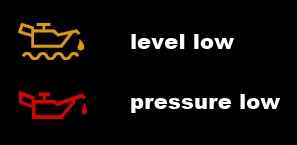 Some engines are equipped with a low oil level light, but those are mostly found in luxury cars. If you don’t own a luxury car, chances are your oil light is about oil pressure, not oil level.
Some engines are equipped with a low oil level light, but those are mostly found in luxury cars. If you don’t own a luxury car, chances are your oil light is about oil pressure, not oil level.
Then there’s the oil change reminder light–totally different topic. Those have nothing to do with oil pressure or oil level.
Oil light on? Check oil level first
Get a clean rag or paper towel. Pop the hood and remove the dipstick. Pull it all the way our and wipe off whatever oil is on the dipstick. Then reinsert it into the tube and make sure it’s seated all the way. Then remove it a second time and check your engine oil level. If should be between the LOW and FILL lines. If it’s at the bottom of the dipstick, add oil before you consider any other fixes.
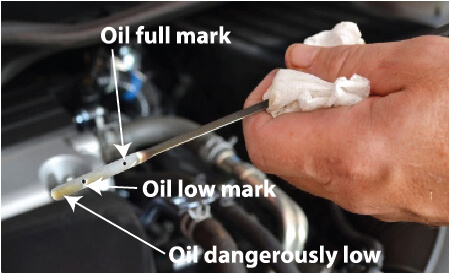
Will low oil level cause an oil pressure light to come on?
You bet, but only when oil level is so low that the oil pump can’t provide enough oil to maintain pressure. So your first job is to check the oil level on your dipstick. If your oil is at the right level and your oil light is still on, you’ve got an oil pressure problem.
Engine oil level is fine, oil light still on
Now you’re faced with a dilemma—is the oil pressure sensor telling the truth, or do you have a much bigger problem? The first question a mechanic would ask is, “Have you been following the car maker’s oil change schedule?” If so, then I’d move severe engine wear a bit lower on the list of possibilities. But if you’ve neglected oil changes, you run a pretty good chance that you’ve damaged your engine.
Here’s the next question: Does the oil light come on only when you’re at a stop, or does it come on when you’re driving? Remember, the oil light goes out when oil pressure exceeds 7-psi. When an engine is at idle speed, it’s not spinning the oil pump as fast. If bearing clearances or the oil pump have worn to the point where it can’t maintain enough oil pressure at idle speed, you’re looking at a fairly large repair bill. But you’re not at that point until you conduct a second oil pressure test.
Is it a bad oil pressure sensor?
Yeah, it could be. A shop would remove the old sensor and attach a mechanical 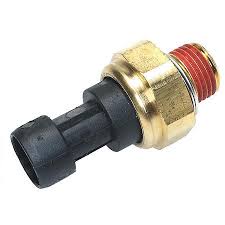 oil pressure gauge to measure the actual oil pressure. If the oil pressure gauge reads the right pressure, then the oil pressure sensor would be replaced. How often does and oil pressure sensor go bad? Often enough.
oil pressure gauge to measure the actual oil pressure. If the oil pressure gauge reads the right pressure, then the oil pressure sensor would be replaced. How often does and oil pressure sensor go bad? Often enough.
If you want to try fixing this yourself, I’d recommend replacing the oi pressure sensor before taking it to a shop for further diagnosis. A new oil pressure sensor is fairly cheap, around $30. Oil pressure sensors are often called an oil sending unit or an oil pressure switch. You’ll need a special oil pressure socket, to remove the old unit and install the new oil switch, but you can usually rent those from an auto parts store. If the store doesn’t rent tools, buy an oil pressure sensor socket.
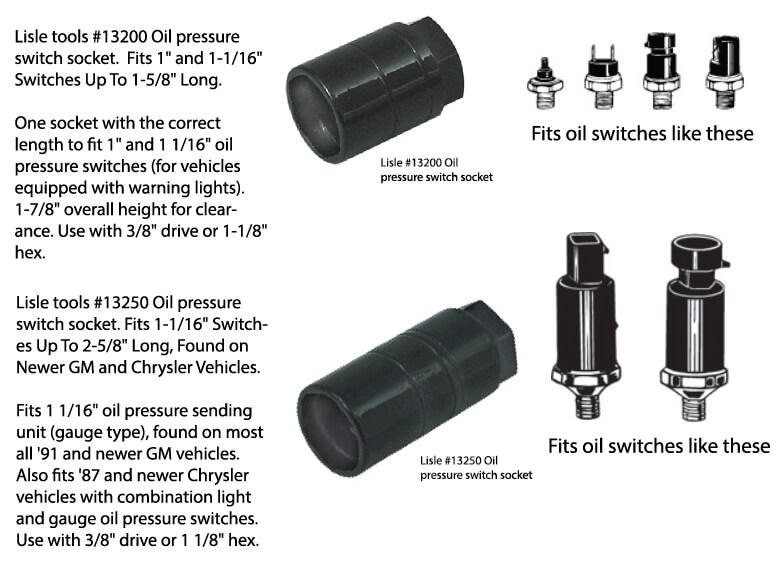
What if a new oil pressure switch doesn’t solve the problem?
If you’ve installed a new oil pressure sensor and you still have an oil light on problem, then you’re left with three possibilities, none of them good.
You could have a stuck oil pressure relief valve. Some are located 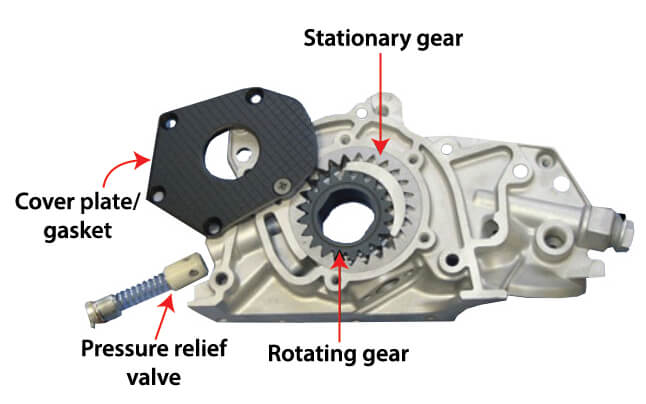 near the oil filter, but others are located in the oil pump itself. That would require dropping the oil pan to access the pump. Due to the labor involved in replacing a pressure relief valve, it makes no sense to put it back together with the old pump.
near the oil filter, but others are located in the oil pump itself. That would require dropping the oil pan to access the pump. Due to the labor involved in replacing a pressure relief valve, it makes no sense to put it back together with the old pump.
You could have a worn engine oil pump. Most people breathe a sigh of relief that “it’s just a bad oil pump,” but oil pumps don’t go bad on their own—they’re killed by lack of proper oil changes. If you replace just the pump, you may buy yourself a little time, but chances are you’ve damaged the engine to the point where it too will fail soon.
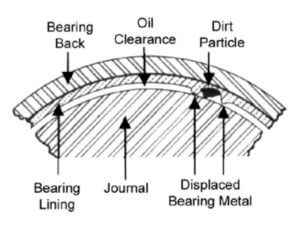 Worn bearings. This is a common failure because
Worn bearings. This is a common failure because 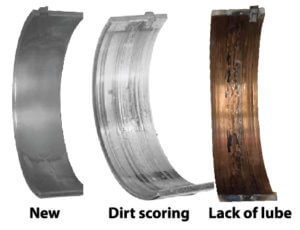 bearing clearances are so small that even a small amount of bearing wear creates a big drop in oil pressure. The best way to check for crankshaft bearing wear is to use plastigauge. Here’s how to measure bearing wear with the crankshaft in the engine.
bearing clearances are so small that even a small amount of bearing wear creates a big drop in oil pressure. The best way to check for crankshaft bearing wear is to use plastigauge. Here’s how to measure bearing wear with the crankshaft in the engine.
Check crankshaft bearing wear with plastigauge
• Remove oil pan
• Use floor jack and block of wood to support crankshaft journal so it’s centered between bearings.
• Remove a bearing cap and install a section of plastigauge.
• Reinstall bearing cap and torque to specifications. Then remove bearing cap and measure the spread distance of the plastigauge. Compare to chart on package.
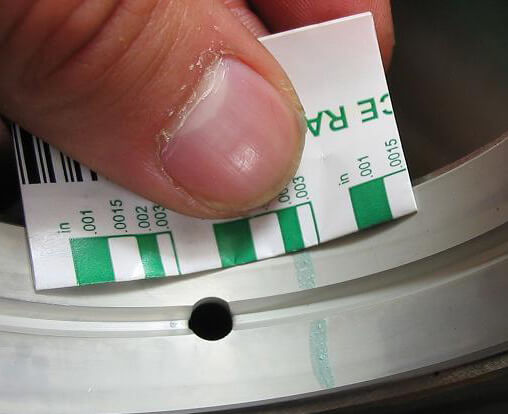
Most common causes of engine bearing wear
Dirt causes engine bearing wear 45% of the time. Not changing oil on time. Driving too long on a clogged oil filter. Not changing air filter on time.
Insufficient lubrication causes bearing wear 11.4% of the time. Running your engine when it’s low on oil, or using too high a viscosity oil.
Corrosion causes bearing wear 3.2% of the time. Running oil too long between oil changes depletes anti-corrosive additives, engine overheating, coolant leaking into oil, excessive blow-by gasses due to worn piston rings, and acids, gasoline and condensation in oil from excessive cold starts and short trips.
Replacing worn bearings is a temporary measure
If you replace worn bearings or a worn oil pump without first discovering what caused those items to fail, you’re asking for trouble, because those items will fail again.
©, 2016 Rick Muscoplat
Posted on by Rick Muscoplat
